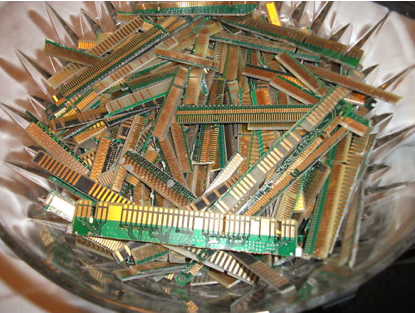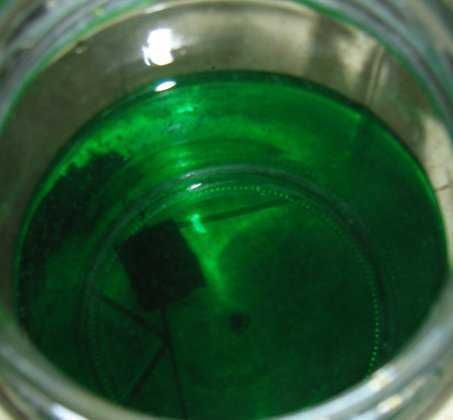Recycling gold from scrap electronics for fun and profit.
technology·@bohemianhacks·
0.000 HBDRecycling gold from scrap electronics for fun and profit.
Howdy Steemit! This is a guide to reclaiming gold from electronics using some fairly hazardous household chemicals so before we get started: You attempt this at your own risk. The acids and fumes used in this process can cause **bodily harm and death** if not handled properly. Use proper ventilation and safety gear to avoid having a bad day. **All plastic should be polypropylene or another non-reactive material.** ## Safety equipment: Nitrile gloves Eye protection WITH splash proctection Respirator(not dust mask) A well ventilated area ## Chemicals: Household bleach(unscented) Hydrogen Peroxide Hydrochloric Acid(Muriatic acid, found in hardware stores for etching concrete) Copper(Optional) Sodium Metabisulfite(Bonide brand stump remover is a good source generally, but beware other brands are Potassium Nitrate) ## Tools: Several glass "beakers"(I got wide mouth vases at a dollar store) Pyrex or glass measuring cups Filter paper(Coffee filters will work for most steps but a good quantitative filter paper is best) Non-reactive plastic funnels Tin snips Spray Bottle Ok, lets get started! ## Step 1. Clean and Prepare. First find a well ventilated area where you can leave your beakers to react without fear for several days. Next you will need to cut off the gold "fingers" from your graphics card or otherwise isolate the high gold content sections of the PCBs. For the purposes of this guide I will assume you are using broken video cards. Snip off the PCI connectors using the tin snips.  Clean them off with isopropyl alcohol if they are excessively dirty and let them dry. ## Step 2. Mix the base solution for dissolving unwanted copper. The solution used here is called Copper Chloride. It is made by mixing Hydrochdloric Acid and Copper. The reaction can be accelerated/renewed by adding Hydrogen Peroxide, and the base solution can be formed faster by adding some copper to the solution rather than waiting for it to etch out the copper pads on the fingers.  Add the fingers to one of your clean beakers, to save on reagents you can cut them into smaller pieces to be more easily submerged. **Now its time to put on some safety gear and break out the acid!** Eye protection, gloves, and a respirator are required any time you handle Hydrochloric Acid! With proper safety equipment, carefully pour enough acid to submerge the fingers. You may notice some tiny bubbles coming from the fingers during this process. To jump start the process you can add a small amount of copper to the solution(A few centimeters of stripped copper wire will do). Next we will add 50ml of hydrogen peroxide, the amounts here aren't as demanding as later steps as the Copper Chloride solution is fairly flexible. The peroxide simply adds oxygen to accelerate the stripping of copper ions into the solution. This process is actually fairly complex under the hood but feel free to read more on wikipedia. This process will take some time to work. You will be waiting for all the Copper to be dissolved from the fingers allowing the gold "foils" to be lifted from the board. Every few hours or so if you notice the bubbling has stopped, add some hydrogen peroxide. You can also use a small aquarium bubbler to achieve the same oxygenation. If adding the peroxdide has not produced more bubbling from the fingers wait another few hours to ensure the process is complete. This process can take several days depending on number of boards, surface area, temperature, and many other variables. ## Step 3. Separate the foils At this stage the majority if not all of the gold foils should be separated from the boards. The foils will be extremely thin and may break up in the solution but you should see lots of gold flakes floating around when the solution is stirred or shaken(carefully) Take another clean container and place a funnel in the mouth with filter paper. Slowly pour small amounts of the solution into the filter giving time for the solution to drain out the bottom. Once all of the solution has been run through the filter you should have some foils and PCB chunks in both the filter and the mostly dry bottom of the first container. The filtered solution should be free of particles and a deep emerald green and can be stored safely in a well marked plastic or glass container for the next run(or to etch home made circuit board. Next the spray bottle should be filled with pure distilled water and we will begin collecting the foils and pulling out the PCB chunks. This process can take some patience. The general procedure is to spray down the foils in the filter above another container to collect them into a small pile at the bottom while allowing the water to drain. Its important to transfer the foils from both sources into a new clean filter to remove contamination from the copper solution. Pull out the PCB fragments with plastic tweezers or gloved hands making sure to spray them down gently to collect the foils in the filter. ## Step 4. Final dissolution At this point you should have a filter paper of extremely clean gold foils with no green solution visible on the filter paper. This is actually a marketable product and many people stop here to sell at a lower purity after melting into small "nuggets". But we want chemically pure gold! I will digress into a small historical note for a moment. For most of human history gold was only dissolved with Aqua Regia(Royal Water), a mixture of nitric and hydrochloric acid. One of the things that makes gold valuable is the fact it is fairly non-reactive so the mixture able to reliably dissolve it was highly valuable itself. However for a modern day backyard chemist it can be a bit of a barrier to entry to buy nitric acid, while still available from various chemical supply or jeweler's shops it isn't exactly a household chemical. We will be using a slightly more arcane mixture of bleach and hydrochloric acid that will produce some highly hazardous fumes and the exact mixing may be less scientific. It is important to find unscented additive free bleach for this, generic or store brands are usually the best bet. To start add the filtered foils(paper and all) to a new clean container and add enough hydrochloric acid to cover them. Next add a few milliliters of bleach at a time while stirring/swirling. A pipette or polypropylene turkey baster/eye dropper is extremely helpful. We are shooting for the minimum needed to dissolve the gold foils as the bleach will be producing highly hazardous chlorine gas.  ## Step 5. Precipitating out the gold and final notes. At this point you should have a yellow solution with some pulpy bits from the remains of the filter. We will repeat the process from filtering out the solids before into a new clean container, this time the gold is in the solution rather than the solids. After you have filtered out the solids you can begin adding the sodium metabisulfite in tiny amounts while stirring. This should cause the gold to precipitate out in extremely small particles. You can create a test solution to check for dissolved gold but that is out of the scope of this guide, search for stannous chloride). Instead we will be carefully adding and dissolving small amounts until some collects on the bottom. Finally filter with quantitative filter paper and rinse with distilled water as we did for the foils, yay gold! ### Notes: This is a very rough beginners guide. I highly recommend learning some basic lab safety as well as researching around the internet(lots of video guides on youtube). Gold refining is science but it takes some artistry to perfect a home lab process. The more times you filter and clean between stages the higher quality product you will end with. I've left out instructions for melting down the gold as it would be a small guide on its own. That alone can take foils into a decent product. While a fun way to brush up on lab skills or help fund a home lab it isn't going to make you rich overnight, unless you are getting lots of finger boards for free/cheap it isn't a very profitable use of time. Enjoy! BohemianHacks
👍 bohemianhacks, sammosk, scooter77, talltim, ladiesman217, ausbitbank, allyouneedtoknow, elevator09, stevepaul, v4vapid, kiporen212, geoffrey, shayne, ayeshanor, grimboslice819, lepton, shauna27, dimitrya123, team-leibniz, gregario, runridefly, steemtruth, bouraralage, steemit-life, r4fken, carebbear, sawang, korgulos, teamsteem, pnc, lamech-m, steembets, beng05, steem-id, lauralemons, thegame, steemland.com, steemprentice, crawfish37, pate194800, crystalgeometry, ariafliandi, kyle.anderson, canadian-coconut, almost-digital, maysilles, iamwne, ayishagisel, busypaws, anyx, kushed, stone1, steemychicken1, stoner19, hagie, lifeisawesome, kingsmind, romedog, spg, berniesanders, joseph, chhaylin, fabio, juneaugoldbuyer, knozaki2015, allasyummyfood, capitalism, yoshiko, thisisbenbrick, sirwinchester, einsteinpotsdam, zahnspange, steemsquad, allesgruen, dannystravels, jerryblanceton, timbernana, sunshinetraveler, wackou, pkattera, ebargains, vannour, patrice, picokernel, strangerarray, cube48, berkah, bue-witness, boy, bue, mini, healthcare, ozchartart, bunny, moon, daniel.pan, helen.tan, craigslist, ozmaster, coinbar, steemizen, vladimirputin, historyoffuture, angelamerkel, memefactory, reelmusic, aurovine, blockpool, tradelord, syn999, tensorflow, timsnaj, genesis91, dobro88888888, quinneaker, ethios17, volcom2558, artbyrasho, kalamur, jedzeppelin, manofaction89, ina.nik, supergist,